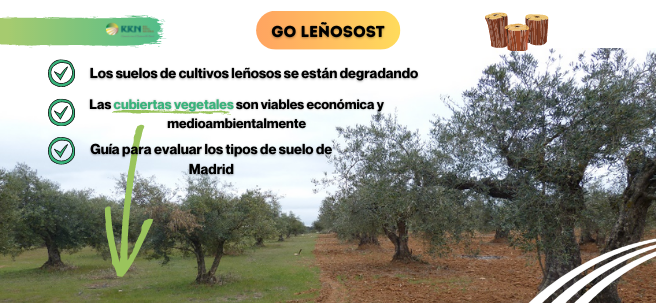
24 de February de 2022
Innovación
- Adaptation to climate change and the new CAP make vegetation cover a sustainable alternative for conserving this type of soil.
- The group has created a guide to assess the quality of soil types in the Community of Madrid.
The conservation of woody crop soils is at risk in many regions of Spain. These plantations are, as defined by the Andalusian Regional Government, "crops that occupy the land for long periods or do not need to be replanted after each harvest," such as fruit tree plantations, nut trees, and olive trees, but not those used for firewood or timber.
The Leñosost Operational Group (OG) has been working since 2018 in the Las Vegas region (Madrid) to analyze how to protect them, since the degradation problems there are particularly aggressive.
One of the most important objectives of the GO has been the "selection of plots in which to test vegetation cover ," a system of covering through the planting of different species that can maintain and improve soil quality.
Lower profitability, greater sustainability
Leñosost—thanks to an olive harvesting cost calculator created for the project—has concluded that cover crops entail higher costs for farmers due to the smaller productive plot size, which reduces profitability compared to conventional tillage.
However, the eco-schemes included in the new CAP 2023-2027 (Practices 6 and 7) They can be the guarantee that allows profitability to exceed conventional tillage, since they will differentiate the management of the plot, which can lead to the covered areas receiving help that the rest will not receive to "prevent soil erosion and degradation."
Once that problem has been overcome, Blanca Esther Sastre , project coordinator, assures that green roofs offer great environmental advantages :
- Greater carbon sequestration compared to tillage.
- They are also natural enemies of pests .
- They have better infiltration , which improves the amount of water in the soil.
Short-term danger
Another objective of the GO has been to raise awareness among farmers with woody crops about the danger their land faces. The rate of soil degradation in these crops is higher than the recommended rate for soil renewal, which means more fertile soil is being lost than is being created. This means that in "10, 20, or 40 years, that soil won't be there," says Sastre.
Many farmers the GO spoke with were interested in using covers, but often failed to implement them due to a lack of information and external references.
A guide to valuing land
The GO has developed a guide called “How to assess the quality of your soil?” , based on the “Visual Soil Assessment (VSA) Field Guide” of the Food and Agriculture Organization of the United Nations (FAO) .
The team participating in Leñosost is made up of Gloria Bermejo López , Consolida Bionatura, SL (Carlos Díaz Brea), Bodega Qubél, SL (Carlos Gosálvez), the Autonomous University of Madrid (José Manuel González Sancho), UTW (Julio Díaz Hernández), UPA Madrid (Jesús Anchuelo) and IMIDRA (Sergio López Vaquero).
The project is part of the Rural Development Program of the Community of Madrid and co-financed by the European Union's EAFRD fund (80%), the Community of Madrid (14%) and the General State Administration (6%).









